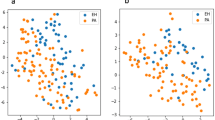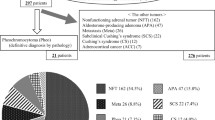Abstract
The aim of the present study is to compare the diagnostic performance of CT and MR imaging in detecting aldosterone-producing adenoma and to compare the interobserver variability in the detection of an aldosterone-producing adenoma on CT and MR. A retrospective study of 34 patients with primary hyperaldosteronism was performed. A total of 17 cases of aldosterone-producing adenoma and 17 cases of bilateral adrenal hyperplasia were included. The final diagnosis of an adenoma was made by surgery with histological confirmation, whereas that of bilateral adrenal hyperplasia was made on adrenal venous sampling or a good biochemical and clinical response following medical treatment alone and in the absence of a unilateral radiological abnormality. The CT (n=30) and MR (n=24) scans were reviewed independently by two radiologists experienced in adrenal imaging, who were unaware of the cause of the primary hyperaldosteronism. The diagnostic performances of both observers in detecting an aldosterone-producing adenoma on CT and MR imaging were compared. The 16 adenomatous nodules that were detected on imaging ranged from 1 to 4.75 cm in diameter. The calculated sensitivity and specificity for detecting aldosterone-producing adenoma were 87 and 93% for one observer and 85 and 82% for the other observer on CT, and 83 and 83% for one observer and 92 and 92% for the other observer on MR, respectively. Receptor operating characteristics curve analysis showed similar performances of both observers in detecting an aldosterone-producing adenoma on CT and MR imaging. There was good interobserver agreement on CT (k=0.71) and on MR (k=0.67). We have demonstrated comparable diagnostic performance and good interobserver agreement on CT and MR imaging for the detection of aldosterone-producing adenoma.




Similar content being viewed by others
References
Grossman A (1998) Clinical endocrinology, 2nd edn. Blackwell, Oxford, pp 436–437
Sheaves R, Goldin J, Reznek RH et al. (1996) Relative value of computed tomography scanning and venous sampling in establishing the cause of primary hyperaldosteronism. Eur J Endocrinol 134:308–313
Rossi GP, Matteo CC, Tregnaghi A, Zanin L, Perale R et al. (1993) Imaging of aldosterone-secreting adenomas: a prospective comparison of computed tomography and magnetic resonance imaging in 27 patients with suspected primary aldosteronism. J Hum Hypertens 7:357–363
Dunnick NR, Leight GS Jr, Roubidoux M, Leder RA, Paulson E, Kurylo L (1993) CT in the diagnosis of primary aldosteronism. Am J Roentgenol 160:321–324
Ikeda DM, Francis IR, Glazer GM, Armendola MA, Gross MD, Aisen AM (1989) The detection of adrenal tumours and hyperplasia in patients with primary aldosteronism: comparison of scintigraphy, CT and MR imaging. Am J Roentgenol 153:301–306
Doppman JL, Gill JR Jr, Miller DL et al. (1992) Distinction between hyperaldosteronism due to bilateral hyperplasia and unilateral aldosteronoma: reliability of CT. Radiology 184:677–682
Magill SB, Raff H, Shaker JL et al. (2001) Comparison of adrenal vein sampling and computed tomography in the differentiation of primary aldosteronism. J Clin Endocrinol Metab 86:1066–1071
Phillips JL, Walther MM, Pezzullo JC et al. (2000) Predictive value of preoperative tests in discriminating bilateral hyperplasia from aldosterone-producing adrenal adenoma. J Clin Endocrinol Metab 85:4526–4533
Harper R, Ferrett CG, McKnight JA et al. (1999) Accuracy of CT scanning and adrenal vein sampling in the preoperative localisation of aldosterone-secreting adrenal adenomas. Q J Med 92:643–650
Lumachi F, Marzola MC, Zucchetta P et al. (2003) Non-invasive adrenal imaging in primary hyperaldosteronism. Sensitivity and positive predictive value of radiocholesterol scintigraphy, CT scan and MRI. Nucl Med Commun 24:683–688
Sohaib SA, Peppercorn D, Allan C et al. (2000) Primary hyperaldosteronism (Conn syndrome): MR imaging findings. Radiology 214:527–531
Doppman JL (1993) The dilemma of bilateral adrenal cortical nodularity in Conn’s and Cushing’s syndrome. Radiol Clin N Am 31:1039–1050
Lingam RK, Sohaib SA, Vlahos I et al. (2003) CT of primary hyperaldosteronism (Conn’s syndrome): the value of measuring the adrenal gland. Am J Roentgenol 181:843–849
Author information
Authors and Affiliations
Corresponding author
Rights and permissions
About this article
Cite this article
Lingam, R.K., Sohaib, S.A., Rockall, A.G. et al. Diagnostic performance of CT versus MR in detecting aldosterone-producing adenoma in primary hyperaldosteronism (Conn’s syndrome). Eur Radiol 14, 1787–1792 (2004). https://doi.org/10.1007/s00330-004-2308-2
Received:
Revised:
Accepted:
Published:
Issue Date:
DOI: https://doi.org/10.1007/s00330-004-2308-2




